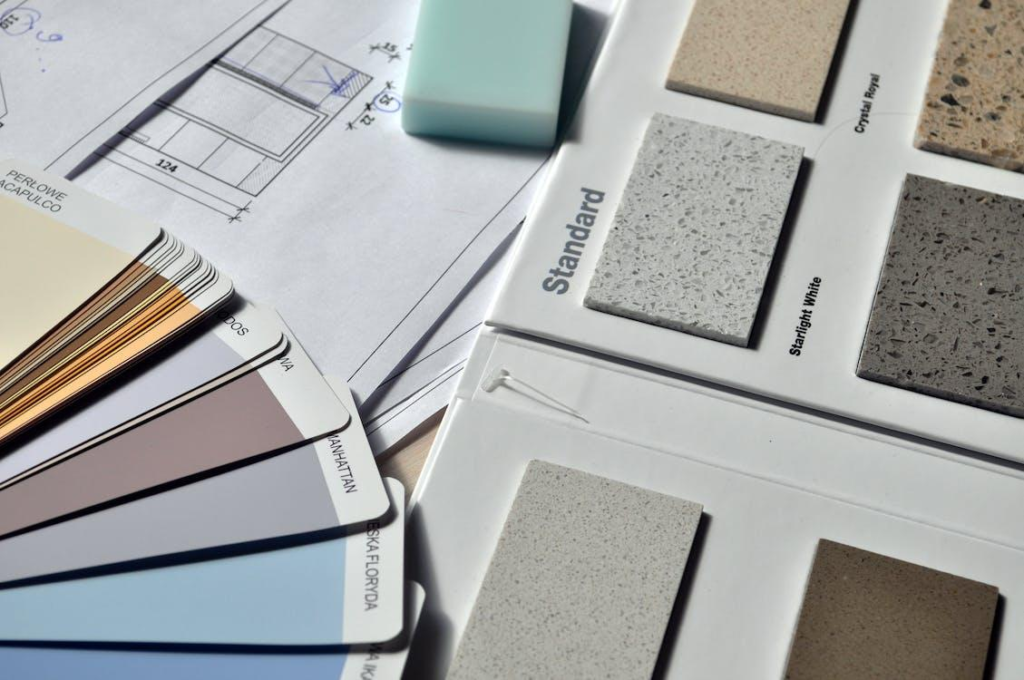When it comes to home improvement, choosing the right flooring materials is a crucial decision. Your choice of flooring not only sets the stage for the overall aesthetic of your home but also plays a vital role in terms of durability and functionality.
Each room in your house has its unique requirements, so it’s important to select the flooring materials that best suit each space. In this blog, we’ll guide you through the process of selecting the perfect flooring materials for every room, ensuring a balance between style, durability, and functionality.
1. Consider the Room’s Function
Each room in your house serves a different purpose, and the flooring materials you choose should align with those functions. Here are a few examples:
Living Room
The living room is often a space for relaxation, entertainment, and social gatherings. Consider flooring materials that are comfortable underfoot and can withstand frequent foot traffic. Hardwood flooring provides an elegant and timeless look, while laminate or luxury vinyl flooring can mimic the appearance of hardwood at a more affordable price point.
Kitchen
The kitchen is often called the heart of the house. It is a high-traffic area for which it is best to choose flooring materials that are not only durable but also easy to clean. Porcelain or ceramic tiles are excellent choices as they are highly resistant to water damage and come in various designs to suit your style. Vinyl flooring is another practical option known for its moisture resistance and wide range of patterns and colors.
Bathroom
Bathrooms require flooring materials that can withstand moisture and minimize the risk of slips and falls. Porcelain or ceramic tiles are popular due to their excellent water resistance and easy maintenance. They can be cleaned effortlessly and are available in a wide array of styles. Alternatively, vinyl or linoleum flooring offers good water resistance and can provide a warmer feel underfoot.
Bedroom
Comfort and style are essential factors to consider when choosing flooring materials for the bedroom. Carpeting is a classic choice as it provides warmth, softness, and a cozy ambiance. Hardwood or engineered wood flooring can also add elegance to the bedroom while maintaining a warm and inviting atmosphere.
2. Assess Durability
The durability of flooring materials is crucial, especially in high-traffic areas or homes with children and pets. Consider the expected foot traffic and the likelihood of wear and tear in each room. Here are some durable flooring options:
- Hardwood:Hardwood flooring is known for its durability and longevity. It can withstand heavy foot traffic and can be refinished if necessary, extending its lifespan.
- Laminate:Laminate flooring is highly durable and resistant to scratches, stains, and fading. It is a cost-effective alternative to hardwood and can mimic the look of various natural materials.
- Vinyl:Vinyl flooring is durable, easy to maintain, and resistant to water, stains, and scratches. It is an excellent choice for high-traffic areas and homes with pets or children.
3. Take Lifestyle and Pets into Account
Consider your lifestyle and any specific requirements related to pets or young children when selecting flooring materials. Here are a few considerations:
- Pets:If you have pets, especially larger dogs with sharp claws, opt for flooring materials that are scratch-resistant. Hardwood flooring with a protective finish, tile, or luxury vinyl flooring are good options. Avoid materials like bamboo or softwoods that may be more susceptible to scratches.
- Children:For homes with young children, consider flooring materials that are easy to clean and can withstand spills and accidents. Stain-resistant carpeting, laminate, or vinyl flooring are practical choices.
4. Evaluate Maintenance Requirements
Different flooring materials have different maintenance needs. For example, hardwood flooring requires regular maintenance, including periodic refinishing and proper cleaning, to preserve its appearance and durability. On the other hand, laminate flooring is relatively low-maintenance and easy to clean. Regular sweeping or vacuuming and occasional damp mopping are typically sufficient. Tile and vinyl flooring are also easy to clean with regular sweeping or vacuuming and occasional mopping. They are resistant to stains and spills, making maintenance more straightforward.
5. Coordinate with the Overall Style
Flooring is a significant component of your home’s overall aesthetic. Consider the existing decor, color schemes, and furniture in each room to ensure that the flooring materials you choose complement the overall style and create a cohesive look. For example:
- Traditional Styles:Hardwood flooring, especially oak or maple, complements traditional and classic interior designs.
- Modern Styles:Sleek, minimalistic designs often pair well with laminate or luxury vinyl flooring options that mimic the look of hardwood or stone.
6. Seek Professional Advice
Choosing the right flooring material can be a tough decision. The Home Menders have flooring experts who can provide personalized recommendations based on your specific needs and preferences. We can guide you through the selection process, explain the pros and cons of different materials, and offer valuable insights to help you make an informed decision.
Whether it’s hardwood, laminate, vinyl, tiles, or carpet, The Home Menders can assist you in finding the perfect flooring materials to transform your house into a comfortable and stylish home. Contact us today!

